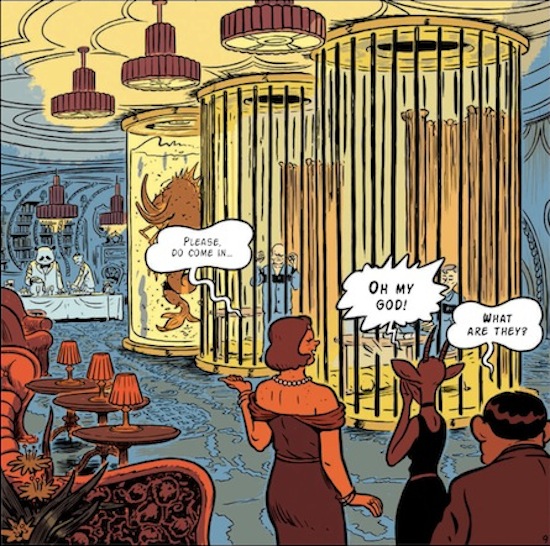H…H…H…Back in Boston, MA, around 2000, well before Paris Hilton starting using the word, we’d call just about anything that fit the description ‘hot’, quickly shortening it to ‘H’. I’ve always liked the letter H. Heck, I even named one of my bands H Bird. The 8th letter of the alphabet, first letter of Hermes, and what do you know, 8 is also his number. Knock that 8 on its side and you get the infinity symbol. And just look at H’s two parallel lines that, extended, would run to infinity. But connected by that little helper in the middle.
We’ve got lots of Hs for you this month. As in we’re Hella Heavy on Humanoids. And also, I feel Robert Venditti & Mike Huddleston’s The Homeland Directive deserves an Honourable Mention, as a full review would be difficult without giving away too much. A harrowing vision of national security taken to its extreme, this book is well worth a read.
A few other H.M.’s: IDW’s The Strange World Of Your Dreams comes in a puffy pillow case cover complete with ‘Do Not Remove Under Penalty Of Law’ tag and collects the complete 50’s run of that title. A curio featuring stories of war, horror, romance, and high society and the way these are manifested in the subconscious. Dark Horse has released Victor Santos’ Polar: Came From The Cold. An extremely stylish tale of extremely violent assassins, beautifully done in black and white with orange highlights. And Humanoids’ The Ring Of The Seven Worlds is by turns a fun and dark strange steampunk adventure. Now let’s get to it. Happy Holidays!
Pierre Gabus & Romuald Reutimann – The Fantastic Voyage of Lady Rozenbilt
(pub. Humanoids)
I must say I love this world Gabus & Reutimann have created. Lady Rozenbilt is a wonderful story. Fantastic indeed. Set in the same universe as their District 14 (see below), where humans and anthropomorphic animals coexist on equal terms, it delights and explores in previously unseen corners, focusing on superpowered cat Alfred Bigoodee, aka Voltère. Born to Earthly father and extraterrestrial mother, when he’s not helping out in the District Bigoodee is here apprenticing as a mechanic in Lady Rozenbilt’s crew. The titular voyage shows up the faux refined tastes of the rich as, for example, pre-dinner entertainment is offered as a stroll past three caged creatures – two human criminals and one seamonster. Hidden savageries appear everywhere throughout the book, present in almost every character. Bigoodee strives to stay above this, but even he can’t resist joining his psychic sisters in abusing-for-their-own-amusement the mindcontrol powers bestowed to them by their otherworldly heritage. This bit of cruel fun costs him dearly, moreso than he can imagine at the time. Alienating everyone with his reprehensible views and seeking vengeance against his wealthy aunt, Walter Rozenbilt soon unfurls a catastrophe, the aftermath of which sees Bigoodee frantically searching for his lost love amidst degradation and chaos, immersing himself in filth to solve the mystery of her disappearance. A beautiful book from the art to the story. Highly recommended. Aug Stone
Pierre Gabus & Romuald Reutimann – District 14 Season 2
(pub. Humanoids)
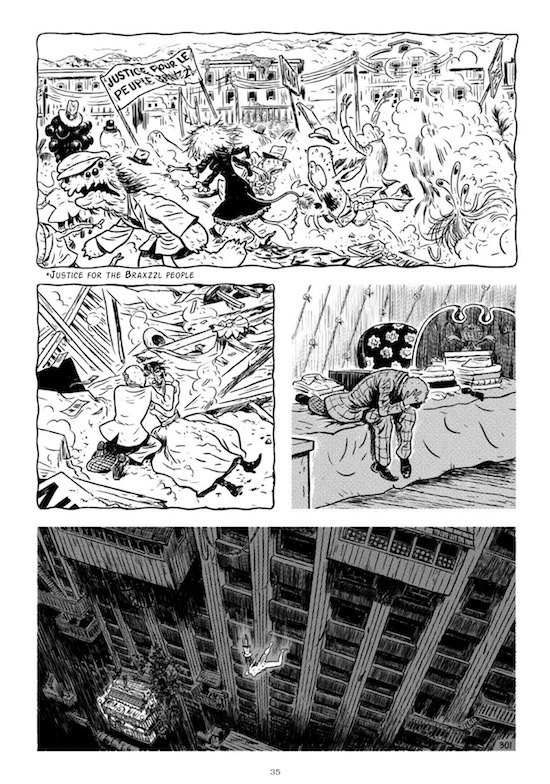
Although this finishes after 600 pages with the words ‘The End’, one hopes that the story will one day continue. It easily could, with each character and plotline so full of depth and life that the individual dramas carry on with you even as the narrative focal point switches between them. Humanoids released Season One earlier this year and Season Two (out in January) progresses even further into and through the hubbub and clamor of this tumultuous city. We see much more of the alien community and their fight against oppression. Intricate emotions are at play here. Beaver journalist Hector’s psychic connection to his deceased wife is threatened unless he can make peace with the fact that she left him for the leader of the Braxzzl people. Meanwhile people’s hero Tigerman stays busy staging heroic acts to obscure his seemier side – trafficking in highly suspicious meats and conducting scientific experiments of great importance with the mentor he holds captive. Two elderly hitmen search for the necessary information to avenge the murder of a beautiful and highly talented benefactor of the city, whose contributions have now been debased. And Michael the elephant’s deformity continues due to deprivation of his medicinal herbs. He’s forced into a life of hiding and crime to pay the extortionate prices demanded for measly amounts of the needed leaves, all the while kept from his cherished Vanita. A plethora of other characters live out their integral roles. We’re witness to corruption galore and much sabotage alongside passion, benevolence, and the struggle for survival. There’s a lot going on in the District and a lot to love. Aug Stone
Alejandro Jodorowsky – Screaming Planet
(pub. Humanoids)
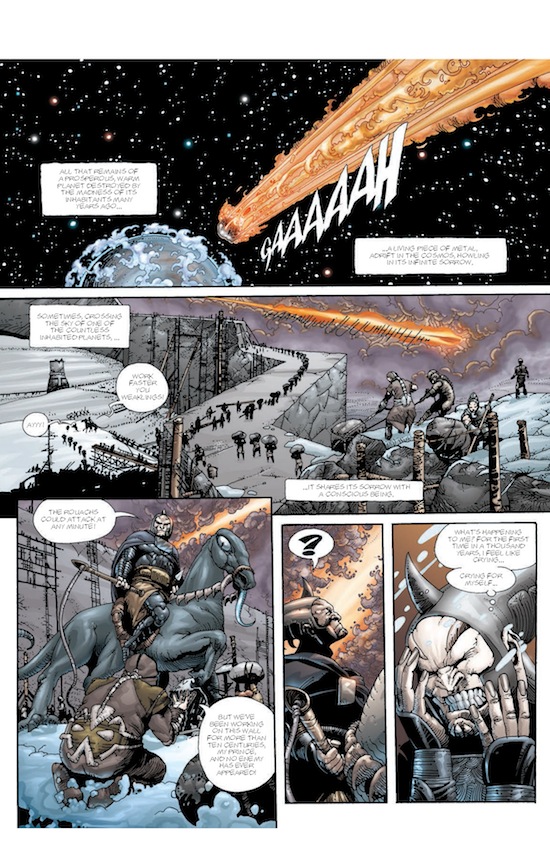
Known for his more sprawling works, when Jodorowsky attempts the short story form as a challenge from Metal Hurlant publisher Fabrice Giger, he does not disappoint. These 10 tales (plus a short prologue) each offer the profound philosophical subject matter we’ve come to expect from the master. Jodorowsky generously give insight in the short prefaces to each story as well as a vital two-page analysis of the process as an introduction to the whole. Originally published between 2002-2004, with a different artist working on each, these parables offer his thoughts on Truth, Guilt, Prophecy/Destiny, Universal Consciousness, Forging One’s Own Soul, Strength, and more. There are dragons, a Robochrist, vampires, a Tigreagle and an Elephantopus. Jodorowsky proves yet again that whatever he turns his hand to is bound to be thought-provoking, rich in poignancy, and clothed in considerable intrigue. Highlights include The Invasion’, ‘The Alchemical Egg’, and ‘Tears Of Gold’, a great allegory showing the lengths people will go to screw each other over for personal gain. Aug Stone
Philippe Riche – Bad Break
(pub. Humanoids)
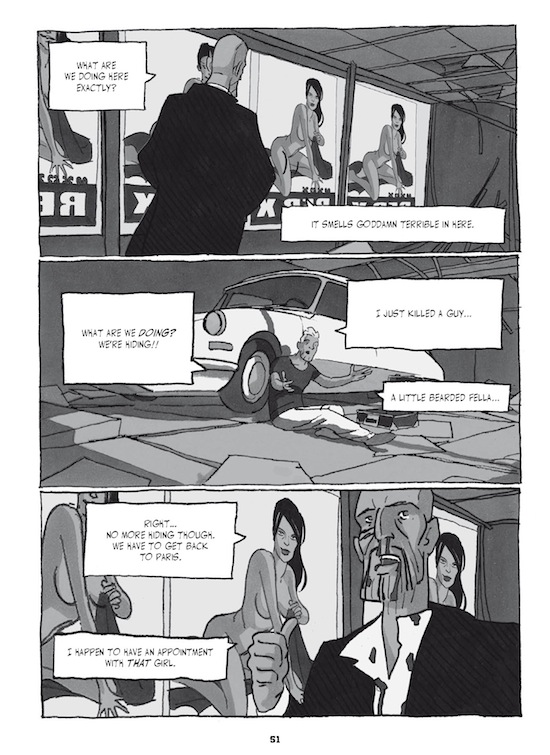
Exploring the same world of antiques and ancient mysteries seen in Alliance Of The Curious, published by Humanoids last year, Bad Break offers even more in terms of story and adventure. Riche’s fascination with skulls continues, here given a mystical significance, and our main quester even buys and sells corpses as his line of trade. The story opens to the sound of facial bandages being ripped off, before our bone broker descends on a cat-infested junkyard, and we’re soon headlong into the world of porn and coded tattoos of yesteryear. Dark grey abounds, and this is indeed noir. Decapitation is a theme, as are love and escape, and vengeance for transgressing the sacred. Characters join in the adventure with a sense of not having much else worth continuing with but end up in a whole heap of other trouble anyway. The main three travel naked for a good part of the story. This struggle moves things along, giving the story its dynamic. Where once sailors and outlaws searched for higher goals – love, fortune – today it is only the story of these old ones that is sought after. A history hinted at in a ‘famous collection of letter’s bound in the author’s own skin’, the cover bearing an enticing tattoo. Intriguing, as this symbol has mysteriously popped up in other places, most recently a porn star’s nether regions. Aug Stone
Saverio Tenuta – Legend of the Scarlet Blades
(pub. Humanoids)
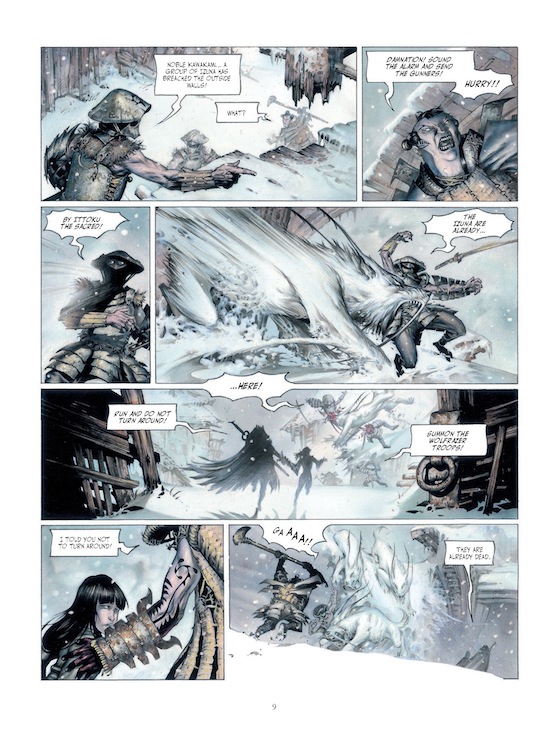
A haunting and haunted story of chilling beauty. This frozen world is inhabited by ice wolves, samurai, peasants with magical knowledge and power, and ruled over by a once-deformed princess whose vanity has plunged their world into chaos and violence. And this violence is extreme. When martial law is declared, the punishment states ‘Whosoever not respect the law will have his face cut off and displayed on his home’s threshold.’ Tenuta’s work is most impressive. The story is fascinating as well as drawn and coloured beautifully. Stark majesty of perpetual winter mixes with the raging emotions underneath as the characters scramble in a frenzied battle against the madness taking over the land. This is also a love story, and one of redemption, for the soul of a village whose destruction brought about vengeance from the natural gods. The emotions at play here are complex and we enter dark mystical territory as Raido, Meiki, and their aides strive to do what is necessary, unawares of what these actions will even bring. To give just one example, as a boy, Raido tore out his eye to feed an Izuna wolf cub. Their great black-coated leader repaid this touching gesture by giving a sleeping Raido one of his own eyes. So when Raido is sent to kill this head of the Izuna pack…
Legend Of The Scarlet Blades is a powerful work with a lot to offer. Aug Stone
Alex de Campi – Smoke/Ashes
(pub. Dark Horse)
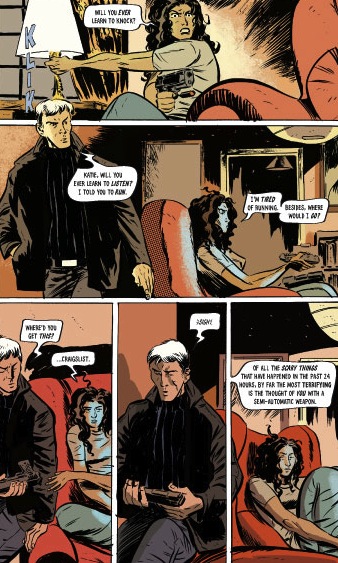
2005’s Eisner-nominated Smoke and last year’s Kickstarter-funded follow-up Ashes are now collected in one volume. This is one hell of a ride, quite literally for a most of the characters. Smoke is set in a then-futuristic 2012 London. Soho is the ‘Walled City’, home to assassin Rupert Cain (who bears more than a passing resemblance to Luther Arkwright). Reporter Katie Shah gets caught up in Cain’s quest to find out what happened to his murdered military superior when she herself becomes entangled in the bizarre cross-section of the oil crises and the Right To Beauty Brigade’s hostage situation. Britain’s upper crust here are reminiscent of the same in The Invisibles, though more plain violent than mystical. And there’s a lot of violence. While Smoke is of London, the city such referred to in its title, as we move to Ashes, there is the "turning away from the caption cannonade of the urban bustle" as Kieron Gillen rightly points out in his intro, and on to more spacious panels which open up the story. Ashes moves us out into the world, to the countryside and on to a top secret U.S. military base where is revealed the harrowing root of the chaos now attacking the world. This is a dark thriller but not without its comic moments – a ‘freak pickling accident’, Blotto beer, and an ad for Mrs. Beaton’s Ready Meals "Because Fresh Food Has Germs!" You can tell de Campi is a knowledgeable lady, ranging from the popular to the obscure. The Raiders Of The Lost Ark pastiche is great and this is the first time I’ve seen mention of Godfrey de Bouillon (a favourite subject of French artist Yves Chaland) in an English-language comic. Pick this up today. Aside from a great read, it’s a beautiful book to behold. Aug Stone
Peter Bagge – Woman Rebel: The Margaret Sanger Story
(pub. Drawn & Quarterly)
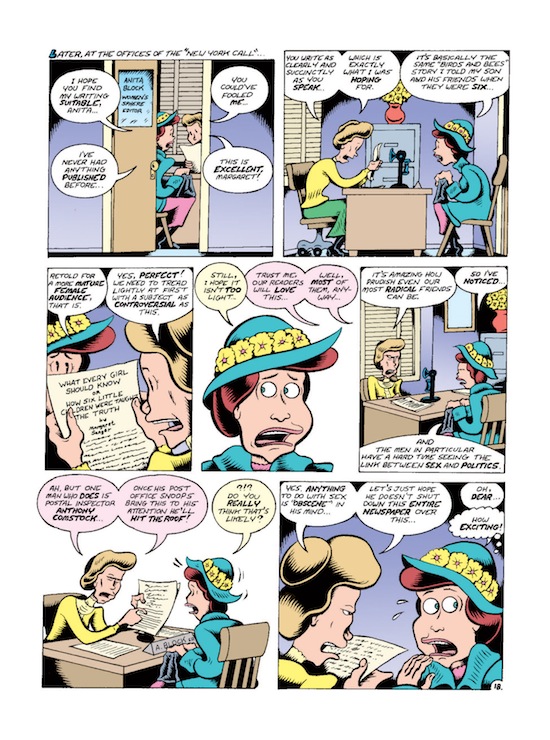
Between a childhood love of Asterix and an adult sense of catching up, my adolescent years were pompous and my adolescent comic-reading pretentious: mostly beginners’ guides to philosophies and thinkers I understood neither at the beginning nor at the end of the book – I was as much as fun as that guy sounds.
I know the comic biography well though and its inevitable failings: necessarily too short to accommodate minutiae; too focussed on story to offer analysis and too focussed on real life to deliver graceful narrative. A life is a large thing for anyone or any medium to summate – especially a real-life – but people and comics have achieved it. Success is attained through simplicity and understanding; a biography in comic form works best as a tribute, a warning, or both.
Peter Bagge’s biography of Margaret Sanger, the mother and planner of planned parenthood, is squarely a tribute, if not a glowing one. She is shown to be irascible, as well as passionate; careless about people’s feelings, as much as she was caring about people. Unswerving in showing her flaws, it saves her from worse: other people’s opinions of her. She is not, as stated elsewhere, a racist, a eugenicist, a fascist, or the inventor of abortion; she was just a woman who showed extraordinary determination in pursuit of just treatment. It is to this determination that the comic pays tribute: it is a document of actions.
The contraceptive pill may have been the most revolutionary circle since the wheel and, while Mrs. Sanger did not invent the thing, her actions and her investment laid its way. It is the dramatic irony here that does the work: to look back on a world so different, makes the change for the better so very clear. The characters don’t know very much about reproductive health, but they know what they have to do. The pill was the little thing that made the big difference, just as Sanger’s frequently small actions made great changes. And then her actions grew bigger.
With its focus on events, Woman Rebel becomes an historical primer – the very same kind that I once used to seem smart – it sets out the facts and sets up further reading, further reading that is kindly provided at the back: a 20 page essay and glossary that answers some questions, but is open to the possibility of more. A comic biography must know what it’s doing, using its strengths so as not to appear slight, inconclusive, or unsophisticated. Woman Rebel does everything that it should: it is interesting, it is contained, and, with a devastating last page, it provides an emotional ending that is more touching and more edifying than the facts that follow or precede it. Or perhaps that is me showing my age. Reggie Chamberlain-King
Written by Joe Harris and Chris Carte, Art by Michael Walsh – The X-Files Season 10 – Issues 1-5 – Believers
(pub. IDW)
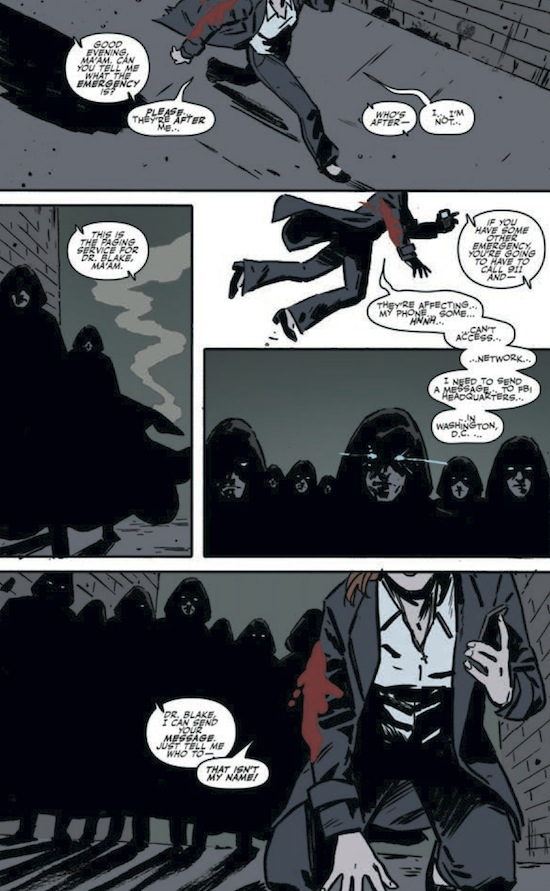
I prefer to think of this as a noble cause, rather than abstruse idiocy: to take up The X-Files at the low-point of its confusing conspiratorial entanglements and draw them out into something sensible. At least, that is my hope, that writer Joe Harris and executive producer Chris Carter (the show’s creator) will try and rehabilitate the mess.
It would have been easier to use one’s licence and set the comic in the mid-show heyday of the programme, when its characters were fully-formed; a swathe could be cut through the knots of paranoia and the imagination unleashed to run amuck amongst the Monster-of-the-Week format. It was always with one-shot grotesques and oddities that The X-Files performed best: hindsight has confirmed this. The Mulder and Scully comic excursions of the 90s – originally published through Topps and re-released this year by IDW – worked on this very premise. The Monster requires one reveal – the monster itself – then moves onto resolution; conspiracy requires one disclosure after another, but can never add up to anything. A conspiracy, by its nature, has to be complex – to create the effect, the audience must always be certain that there is something that they don’t know.
It is brave then to continue on, especially to continue on into a world post 9/11 and have Mulder and Scully in the modern age, still as witty and beautiful. Conspiracy has moved in from the margins now. Aliens, however, are no longer part of the zeitgeist; in the 90s, they were part of the furniture even, and the world half-expected to find them under every rock and in every government office. Times are darker and the things that our agents uncovered must be darker too.
In this regard, the Season 10 opener, Believers, excels: Dr. Scully, renamed under a witness protection programme, is attacked by a group of mysterious, dark figures, accompanied by a white-eyed child that knows her true identity – sadly, the FBI operator on the other line, her only access to help, does not.
Harris does an excellent job in capturing the tone of the show and Mulder and Scully, although obscured by Michael Walsh’s occasionally expressionistic artwork, are recognisable by speech bubble alone. The arc is promising and manages to bring back dead characters in ways that are equally absurd and appropriate: The Lone Gunmen live under Arlington Cemetery and the reanimated corpse of the Cigarette-Smoking Man begs questions that we may never see answered.
By issue 5, the arc has closed, as did the original series, with a ball of tangled plotlines: what happened and why remains an X-File itself. In this case, it is a matter of not enough time, whereas the TV show went on too long. It is not a problem: the show retained its audience through engaging characters, witty scripts, and frequent moments of stand-alone brilliance, not its ability to persuade that its central tenets made sense. As Season 10 purports to be a season in full, we can expect – in addition to confusing revelation after enlightening cover-up – those same things: engaging characters, witty scripts, and frequent moments of stand-alone brilliance. Joe Harris looks like he is capable. Reggie Chamberlain-King
Joe Sacco – The Great War: The First Day of the Battle of the Somme
(pub. Jonathan Cape)
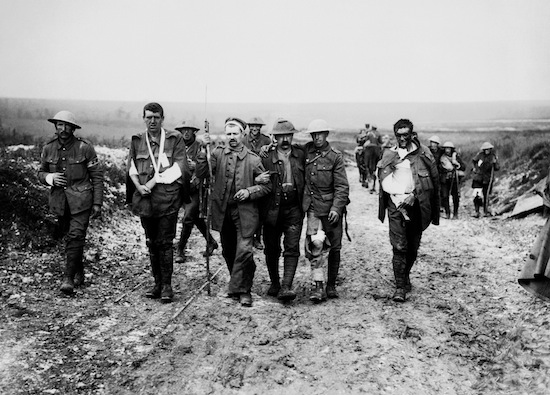
About Joe Sacco’s The Great War, one can write only essays or short, ecstatic sentences. Given the comprehensive essay that comes with it and the little space we have here, the latter must suffice. A beautiful accordion-book, it unfolds on the Western Front, with all its monotony and misery: simple, but intricate; wordless, but vocal; brutal, but beautiful. A masterpiece of quietly affecting numbers, the thousands of lines, dots, and crosses that demarcate the thousands of lives, deaths, and crises. Reggie Chamberlain-King
Oscar Zarate – The Park
(pub. SelfMadeHero)
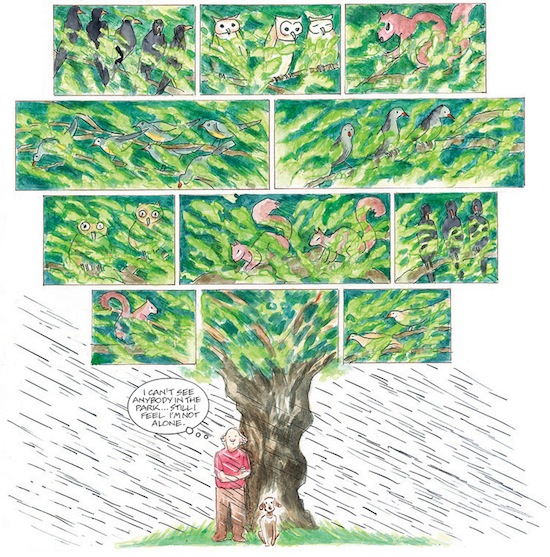
I’ve long been an admirer of Mr Zarate’s art, where human faces take on the air of carnival masks. His characters often resemble performing versions of themselves: dolls, puppets, circus clowns. Sometimes the effect is grotesque, sometimes it’s funny, sometimes it’s seductive. His adaptation of Marlowe’s Doctor Faustus, where Mephistopheles is a sexy 1970s Bowie-esque youth in a Union Jack t-shirt, is one of my favourite comic books full stop. One of his collaborations with Alan Moore, ‘I Keep Coming Back’ (the coda to From Hell), is now a set text on university courses. A few years ago SelfMadeHero reissued Zarate’s 1990s anthology of London-themed tales It’s Dark In London, which includes the Moore tale. His new graphic novel for SMH, The Park, is another take on the sprawling capital. This time, though, the words as well as the art are Zarate’s own.
The titular park is present-day Hampstead Heath, functioning here as the regular haunt of two single fathers, each of whom live with a grown-up only child. There is ranting columnist Ivan and his eco-warrior artist daughter Mel, mild musician Chris and his petulant personal trainer son Victor. Ivan is an all too recognisable figure of English parks, fond of dogs and nature, but not so fond of his fellow man. When Ivan’s dog bites Chris in the park, all four lives become entangled.
Zarate’s book is a superbly observed and loving portrait of its leafy setting, combining an up-to-date London skyline (the Shard is present and correct) with beautiful watercolour renderings of the eternal ponds, paths, trees and wildlife familiar to visitors to the Heath. But he also captures the sense of London as a place where diverse people share the same daily spaces, whether it’s strangers in a park or relatives in flats and small houses. As a result Zarate’s quartet of characters all get an equal share of empathy in the story, with even the arrogant Ivan displaying a tender side in his commentary on the park’s flora and fauna. With moments of romance and slapstick comedy jostling alongside moments of unease, tension and violence, with digressions on Laurel and Hardy’s fight scenes, the pitfalls of blogging, and the way robins use birdsong to conduct their own conflicts, The Park is a rich rendition of life in the bigger spaces of a big city. Dickon Edwards

